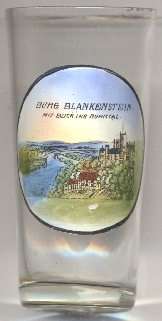

|
| DEUTSCHLAND | GERMANY |
| Bundesland: Nordrhein-Westfalen | North Rhine-Westphalia |
| Regierungsbezirk: Arnsberg | |
| Kreis: Ennepe-Ruhr-Kreis |
Hattingen is situated at an elevation of 90 m on the south bank of the river Ruhr in the immediate vicinity of the cities of Bochum, Essen and Wuppertal. The municipality has a population of about 53,000 (2023).
The town was first mentioned in 1396, when the Duke of Mark (see Hamm) granted permission to build a city wall. Today, Hattingen has a picturesque historic district with timber-framed houses built between the 14th and 16th centuries. The old city is still partly surrounded by the city walls today. Hattingen became part of the Hanseatic League in 1554 and became an important trading town. In 1720, there were 52 operating coal mines within the municipal area and Hattingen became one of the first industrial cities of the Ruhr region. Steel production started in 1853, when the Henrichshütte was founded. The Henrichshütte became one of the most important employers of the whole region and dominated the town until it closed in 1987.

 Blankenstein castle [left, no. 4764]
was built in 1227–1243 but was further developed over the course of 200 years by the Counts of Mark. By 1425, Blankenstein
was one of the most important castles in the county. In 1614, shortly before the Thirty Years' War (1618–1648), it was occupied
by Spanish troops. From 1637 the castle fell into disrepair and it finally was demolished in 1662. Only the tower and parts of the
curtain wall remained. In 1860, parts of the castle were rebuilt to house a factory. Since 1922 the property belonged to the city
of Bochum. Most of the constructions from the 19th century were pulled down between 1957 and 1959, but some still remain.
The tower can still be visited and offers a good view over Bochum and the Kemnader Lake.
Blankenstein castle [left, no. 4764]
was built in 1227–1243 but was further developed over the course of 200 years by the Counts of Mark. By 1425, Blankenstein
was one of the most important castles in the county. In 1614, shortly before the Thirty Years' War (1618–1648), it was occupied
by Spanish troops. From 1637 the castle fell into disrepair and it finally was demolished in 1662. Only the tower and parts of the
curtain wall remained. In 1860, parts of the castle were rebuilt to house a factory. Since 1922 the property belonged to the city
of Bochum. Most of the constructions from the 19th century were pulled down between 1957 and 1959, but some still remain.
The tower can still be visited and offers a good view over Bochum and the Kemnader Lake.
[https://de.wikipedia.org/wiki/Hattingen, https://en.wikipedia.org/wiki/Hattingen;
https://en.wikipedia.org/wiki/Blankenstein_Castle]
![[scale]](lineal.jpg)